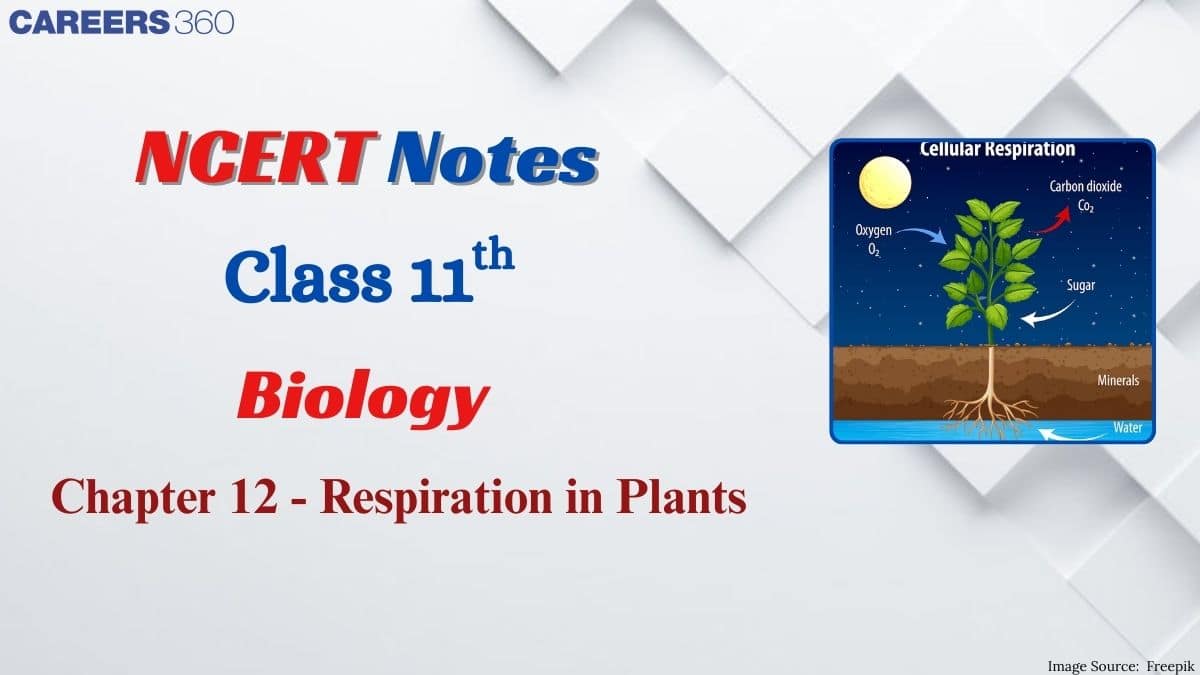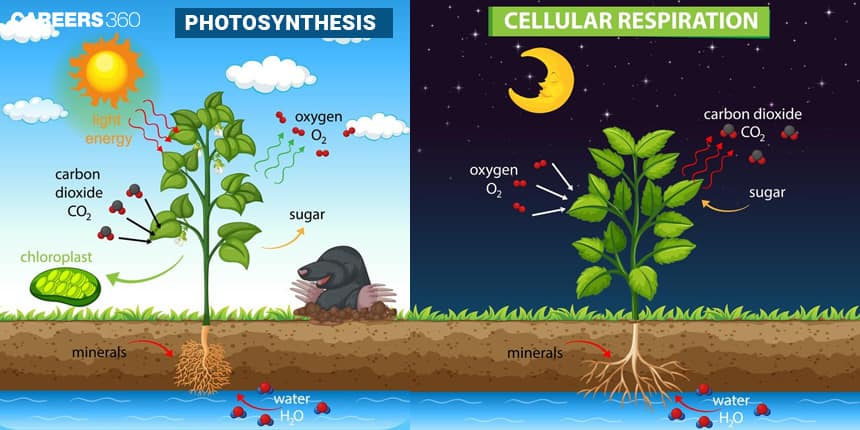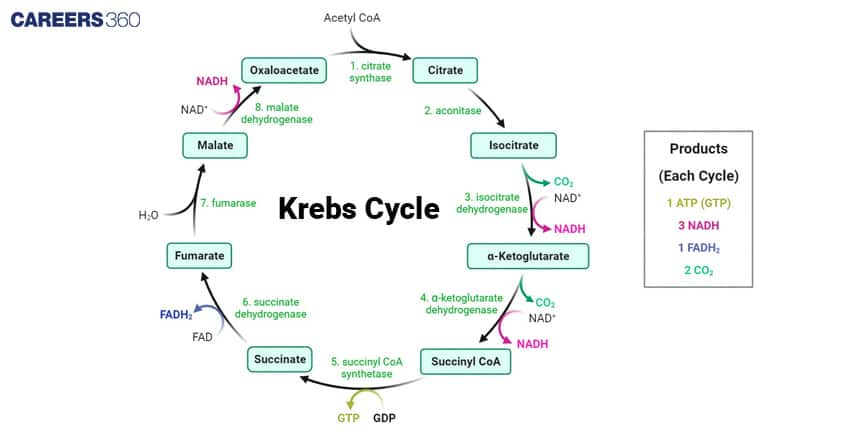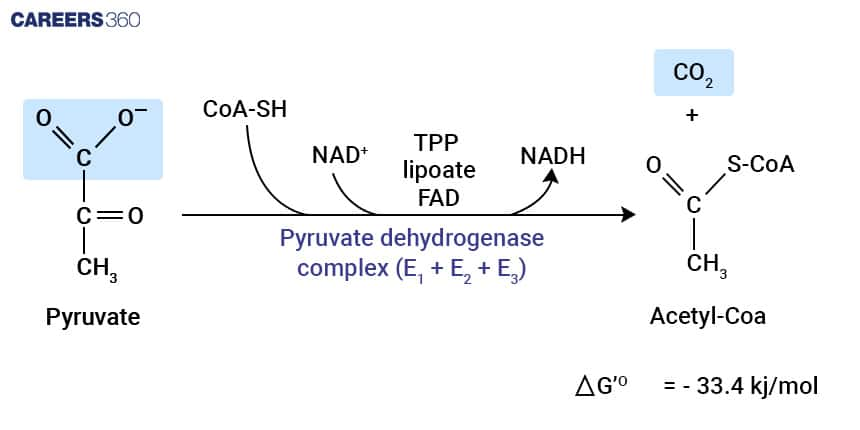NCERT Class 11 Biology Chapter 14 Notes Respiration In Plants - Download PDF Notes
Have you ever asked yourself how plants release energy from the food they make? The NCERT Class 11 Biology Chapter 12 Notes Respiration In Plants answer this question clearly and simply. The chapter covers how glucose is broken down through glycolysis, the Krebs cycle, and the electron transport chain. All the processes are explained in short bullet points, along with well-labeled diagrams. The NCERT Notes are a perfect resource for last-minute revision for board exams as well as NEET.
This Story also Contains
- NCERT Class 11 Biology Chapter 12 Respiration in Plants: Download PDF
- Class 11 Biology Chapter 12 Respiration in Plants Notes
- Chapter 12 Biology: Previous Year Question and Answers
- How to Use Respiration in Plants Class 11 Notes Effectively?
- Advantages of Class 11 Biology Chapter 12 Respiration in Plants Notes
- Chapter-Wise NCERT Class 11 Notes Biology

In the Respiration in Plants Class 11 Notes, students will get easy explanations of each stage of respiration, and also understand how to write answers properly and where to add diagrams in exams. The points are arranged in a particular order in the PDF of NCERT Class 11 Biology Chapter 12 Notes, which is easy to follow. By going through these NCERT Notes for Class 11, students can feel more confident about the other biology chapters and build a strong base.
NCERT Class 11 Biology Chapter 12 Respiration in Plants: Download PDF
This chapter explains how plants release energy from the food they make through different types of respiration. It includes processes like glycolysis, fermentation, and the role of mitochondria. Studying these topics becomes easier when everything is available in one place. Students can now download the PDF of NCERT Class 11 Biology Chapter 12 Notes and revise anytime. For quick and smart preparation, the NCERT Class 11 Biology Notes are best.
Also, students can refer,
Class 11 Biology Chapter 12 Respiration in Plants Notes
Respiration in Plants explains how plants break down food to release energy for their activities and covers topics like glycolysis, the Krebs cycle, and electron transport in a simple way. Students will learn how plants take in oxygen and produce energy at the cellular level. The Respiration in Plants Class 11 Notes also include diagrams and key terms, which are prepared according to the latest NCERT curriculum, making it easier to understand.
Respiration in Plants
Respiration in Plants is a metabolic process where organic compounds, mainly glucose (C₆H₁₂O₆), are decomposed to release energy in the form of Adenosine Triphosphate (ATP). This energy is used in different physiological processes like cell division, growth, repair, transportation of nutrients, and biosynthesis of vital compounds. The overall chemical equation for respiration is:

In contrast to animals, plants lack specialised respiratory organs. They depend on simple diffusion for gas exchange via stomata (in leaves), lenticels (in stems), and root hairs (in roots). Respiration in all living cells takes place constantly to supply their energy needs. The process depends on oxygen availability, temperature, and the respiratory substrate type.
Respiration in plants may be aerobic (oxygen-involving) or anaerobic (oxygen-absent). Aerobic respiration yields a large quantity of ATP, but anaerobic respiration yields less energy and usually results in ethanol or lactic acid production. Respiration is important as it directly affects the survival, productivity, and general metabolic equilibrium of plants.
Types of Respiration in Plants
Plants respire in different ways depending on the availability of oxygen. The two major types of respiration are aerobic respiration and anaerobic respiration, with fermentation being a specific type of anaerobic respiration.
Aerobic respiration
Aerobic respiration is the process by which glucose is fully oxidised in the presence of oxygen (O2) and yields carbon dioxide (CO2), water (H2O), and a lot of ATP (energy).
Location
The process occurs mainly in the plant cells' mitochondria.
Glycolysis, the initial step, happens in the cytoplasm, whereas the subsequent stages (the Krebs cycle and the Electron Transport Chain) happen in the mitochondria.
Process
In Glycolysis (in the cytoplasm), glucose is converted into two molecules of pyruvate, generating a little ATP and NADH.
In the Krebs Cycle (in Mitochondria), Pyruvate is further converted into CO2, yielding NADH and FADH2 molecules.
In the Electron Transport Chain (in Mitochondria), the electrons from NADH and FADH2 are passed through protein complexes, generating ATP. Oxygen serves as the terminal electron acceptor, forming water (H2O).
End Products
Carbon dioxide (CO2) is emitted into the air.
Water (H2O) is used or emitted as a gas.
ATP (Adenosine Triphosphate) is used as the cell's energy currency.
Energy Yield
Aerobic respiration is very efficient, yielding 36-38 molecules of ATP per molecule of glucose, which is vital for different cellular processes in plants, including nutrient transportation, plant growth, and development.
Anaerobic Respiration
Anaerobic respiration is carried out without oxygen. Glucose is partially broken down instead of completely oxidised, forming less energy and byproducts such as ethanol or lactic acid.
Location
Anaerobic respiration is located in the cytoplasm because mitochondria need oxygen to work.
Process
In Glycolysis, Glucose is broken down to form pyruvate in the cytoplasm.
In the Fermentation Pathway, pyruvate is reduced to form ethanol and CO2 (in plants) or lactic acid (in certain microorganisms such as bacteria) rather than going into the Krebs cycle.
End Products
Ethanol (C2H5OH) or Lactic Acid (C3H6O3)
Carbon dioxide (CO2) is released during the process of fermentation.
Only 2 ATP molecules for every glucose molecule.
Energy Yield
Anaerobic respiration is wasteful in comparison to aerobic respiration, as it yields much less ATP (only 2 molecules per molecule of glucose).
Where Does It Take Place in Plants?
Where plant roots are in a low oxygen supply in waterlogged conditions.
In some plant tissues, like seeds during germination, there's a shortage of oxygen.
In some microorganisms that are part of the plant fermentation processes.
Example
Root cells under flooded conditions resort to anaerobic respiration owing to oxygen shortage.
Yeast cells employ anaerobic respiration to produce alcohol.
Fermentation
Fermentation is a special type of anaerobic respiration where glucose is broken down into simpler compounds like ethanol or lactic acid, producing a small amount of ATP.
Types of Fermentation
The types of fermentation include:
Alcoholic Fermentation (in Yeast & Some Plants)
Pyruvate is converted into ethanol (alcohol) and CO2.
Used in the brewing and baking industries.
Lactic Acid Fermentation (in Some Microorganisms)
Pyruvate is converted into lactic acid instead of ethanol.
Occurs in certain bacteria and muscle cells (during heavy exercise in animals).
End Products
Alcoholic Fermentation → Ethanol (C2H5OH), CO2, ATP
Lactic Acid Fermentation → Lactic acid (C3H6O3), ATP
Energy Yield
Produces only 2 ATP molecules per glucose molecule, similar to anaerobic respiration.
Importance of Fermentation
Used in the production of bread, beer, and wine.
Helps in preserving foods like yoghurt and cheese.
Important in some plants and microorganisms for survival in low-oxygen environments.
Comparison of Aerobic, Anaerobic Respiration, and Fermentation
The difference between Aerobic, Anaerobic Respiration, and Fermentation is given below:
Feature | Aerobic Respiration | Anaerobic Respiration | Fermentation |
Oxygen Requirement | Present | Absent | Absent |
Location in Cell | Mitochondria & Cytoplasm | Cytoplasm | Cytoplasm |
End Products | CO2, H2O, ATP | Ethanol or Lactic Acid, CO2, ATP | Ethanol/Lactic Acid, CO2, ATP |
Energy Yield | High (36-38 ATP) | Low (2 ATP) | Low (2 ATP) |
Occurs In | Most plants and all aerobic organisms | Flooded plant roots, certain bacteria | Yeast, some plant cells, and bacteria |
Importance | Essential for energy production and plant metabolism | Helps plants survive in oxygen-deficient conditions | Used in industries (brewing, baking, dairy) |
Respiratory Substrates
The main substrate for respiration is glucose (C6H12O6).
Other molecules, like fats and proteins, can also be used as respiratory substrates.
Respiratory Quotient (RQ) is the ratio of CO2 released to O2 consumed:
For carbohydrates (Glucose): RQ = 1
RQ= CO2 released/O2 consumed
For fats and proteins: RQ < 1
Steps of Respiration in Plants
Plant respiration is a process of successive biochemical reactions that gradually degrade glucose to produce ATP, which is used in cellular functions. It has three primary phases: Glycolysis, the Krebs Cycle (TCA Cycle), and the Electron Transport Chain (ETC) & Oxidative Phosphorylation.
Glycolysis (Cytoplasmic Pathway)
Glycolysis is the initial process of respiration and is carried out in the cytoplasm of the cell. Glycolysis does not involve oxygen and occurs in aerobic as well as anaerobic respiration.
Process
Glucose Activation: A glucose molecule of 6-carbon (C6H12O6) is phosphorylated with the help of ATP and converted into fructose-1,6-bisphosphate.
Cleavage of Glucose: The molecule of 6-carbon is divided into two molecules of 3-carbon of glyceraldehyde-3-phosphate..
Energy Harvesting Phase: The G3P molecules go through a series of phosphorylation and oxidation reactions to yield:
2 molecules of Pyruvate (C3H4O3)
2 molecules of ATP (Net gain)
2 molecules of NADH (utilised further in the ETC)
End Products of Glycolysis
Pyruvate (moved to the next phase: the Krebs cycle if oxygen is available, or fermentation if oxygen is not available).
ATP (utilised directly for cellular functions).
NADH (utilised in the electron transport chain for the production of ATP).
Krebs Cycle (Citric Acid Cycle / TCA Cycle)
The Krebs cycle, otherwise known as the Tricarboxylic Acid (TCA) Cycle or the Citric Acid Cycle, is the second process of aerobic respiration. It takes place within the mitochondrial matrix and is where pyruvate is fully oxidised.

Process
Conversion of Pyruvate to Acetyl-CoA
Pyruvate from glycolysis is converted to Acetyl-CoA by the removal of one CO2 molecule and the generation of one NADH.
Entry into the Krebs Cycle
Acetyl-CoA (a 2-carbon molecule) and oxaloacetate (a 4-carbon molecule) join together to create citrate (a 6-carbon molecule).
Series of Oxidation Reactions
Citrate is transformed through a series of reactions, losing two CO2 molecules and generating NADH, FADH2, and ATP.
Regeneration of Oxaloacetate
Oxaloacetate is regenerated at the end of the cycle so that the cycle can repeat.
End Products per Glucose Molecule (Two Pyruvates)
6 NADH (utilised in the electron transport chain).
2 FADH2 (utilised in the electron transport chain).
2 ATP (available for use in cellular processes).
4 CO2 (excreted as a waste product).
Electron Transport Chain (ETC) & Oxidative Phosphorylation
The Electron Transport Chain (ETC) is the last stage of aerobic respiration, which takes place in the inner mitochondrial membrane. This process produces the maximum number of ATP via a process called oxidative phosphorylation.
Electron Transfer
NADH and FADH2 (formed in previous stages) transfer electrons (e⁻) to the electron transport chain, a chain of protein complexes in the inner mitochondrial membrane.
Proton Gradient Formation
As electrons travel through the complexes, protons (H⁺ ions) are pumped through the inner mitochondrial membrane into the intermembrane space, establishing a proton gradient.
ATP Synthesis (Oxidative Phosphorylation)
The protons flow back to the mitochondrial matrix via an enzyme known as ATP synthase, which powers the reaction
Oxygen as the Final Electron Acceptor
Oxygen (O2) accepts electrons at the end of the chain and combines with protons to make water (H2O). This is the reason why oxygen is vital for aerobic respiration.
End Products
34 ATP molecules (principal ATP production location).
Water (H2O) (created when oxygen accepts electrons).
Factors Affecting Respiration in Plants
Higher temperatures increase enzyme activity up to an optimum level.
More oxygen increases aerobic respiration; limited oxygen promotes anaerobic respiration.
Dry conditions reduce respiration as enzymes need water to function.
Carbohydrates are preferred; fats and proteins require more oxygen for breakdown.
Also Read
Chapter 12 Biology: Previous Year Question and Answers
Some of the questions that have come in past years from the chapter are given below. In exams, to solve these questions effectively, students are advised to read the NCERT Class 11 Biology Chapter 12 Notes Respiration in Plants.
Question 1. Choose the correct statement:
Option 1. Pyruvate is formed in the mitochondrial matrix.
Option 2. During the conversion of succinyl-CoA to succinic acid, a molecule of ATP is synthesised.
Option 3. Oxygen is vital in respiration for the removal of hydrogen.
Option 4. There is a complete breakdown of glucose in fermentation.
Answer :
Oxygen drives the whole process of aerobic respiration and is responsible for driving out hydrogen, which is an important process.
Hence, the correct answer is option (3). Oxygen is vital in respiration for the removal of hydrogen.
Question 2. The Electron Transport System (ETS) is located in the mitochondria
Option 1. outer membrane
Option 2. intermembrane space
Option 3. inner membrane
Option 4. matrix
Answer :
ETS is the electron transport system, which is a carrier molecule that can act as an electron acceptor as well as a donor, and it is present in the inner membrane of mitochondria. The electron transport chain is present in multiple copies in the inner mitochondrial membrane of eukaryotes and the plasma membrane of prokaryotes. It results in oxidative phosphorylation. The ETC is a series of proteins that receive the high-energy electrons from NADH and FADH2 and move them to the final acceptor, molecular oxygen.
Hence, the correct answer is option (3) Inner membrane.
Question 3. Pyruvic acid, the key product of glycolysis, can have many metabolic fates. Under aerobic conditions, it forms
Option 1. lactic acid
Option 2. CO2 + H2O
Option 3. acetyl-CoA + CO2
Option 4. ethanol + CO2
Answer :
Explanation: Acetyl CoA, CO2, and NADH are the products obtained when Pyruvic acid undergoes a dehydrogenation reaction. An organic molecule with a backbone of three carbons, pyruvate is essential to an organism's processes of synthesis and degradation. It is used in bodybuilding supplements, the food business, and cancer screening, and when it is present in abnormal amounts, it is linked to some illnesses.
Hence, the correct answer is option 3) Acetyl-CoA + CO2
Question 4. In which part of the mitochondrion does oxidative phosphorylation occur?
Option 1. Matrix
Option 2. Outer membrane
Option 3. Inner membrane or cristae
Option 4. Intermembrane space
Answer:
Oxidative phosphorylation takes place where the electron transport chain (ETC) components and ATP synthase are located. These structures are embedded in the inner mitochondrial membrane (cristae). As electrons flow through the ETC, protons are pumped into the intermembrane space, and when they return, ATP is produced.
Hence, the correct answer is option 3) Inner membrane or cristae
Question 5. The link reaction between glycolysis and the Krebs cycle occurs in the
Option 1. Cytoplasm
Option 2. Mitochondrial matrix
Option 3. Intermembrane space
Option 4. Nucleus
Answer:
The conversion of pyruvate to acetyl-CoA is known as the link reaction, which connects glycolysis to the Krebs cycle. This reaction takes place inside the mitochondrial matrix, where pyruvate is decarboxylated and combined with CoA to form acetyl-CoA. This acetyl-CoA then enters the Krebs cycle.
Hence, the correct answer is option 2) Mitochondrial matrix
Also Read:
How to Use Respiration in Plants Class 11 Notes Effectively?
Respiration is the process through which plants release the energy stored in glucose to carry out life activities. Understanding this chapter requires regular practice and a step-by-step approach.
- Understand the concepts in stages like glycolysis, the Krebs cycle, and the electron transport chain, for easy learning.
- Use Class 11 Biology Chapter 12 Respiration in Plants Notes PDF to revise the differences between aerobic and anaerobic respiration.
- Draw and label diagrams of mitochondria and pathways to make the process clearer.
- Practice previous year questions and MCQs based on respiration to test the understanding.
- Revise Class 11 Biology Chapter 12 Respiration in Plants Notes before exams for quick revision of important reactions and enzymes.
Advantages of Class 11 Biology Chapter 12 Respiration in Plants Notes
The Respiration in Plants chapter explains how plants release energy from food through various biochemical pathways. Having well-organised notes helps students understand the process of respiration clearly.
- Class 11 Biology Chapter 12 Respiration in Plants Notes PDF makes it easier for students to know pathways like glycolysis, the Krebs' cycle, and the electron transport chain.
- Important equations and reactions are summarised in the notes, which allow them to do quick revision before exams.
- The notes also covered the diagrams and flow charts, which help students to visualise energy production and the role of ATP in the process of respiration.
- Regular revision of these notes clears all the concepts and boosts exam performance in both boards and competitive exams like NEET.
Chapter-Wise NCERT Class 11 Notes Biology
Here are the links to the notes for each chapter to help with your Biology revision.
Frequently Asked Questions (FAQs)
During the day, photosynthesis dominates, producing O₂ and storing energy. At night, photosynthesis stops, and plants rely on respiration to break down stored glucose, generating ATP for cellular functions, growth, and repair.
Mitochondria are the powerhouse of the cell, where the Krebs cycle and ETC occur. They generate most ATP by oxidizing pyruvate, utilizing NADH and FADH₂ to produce energy via oxidative phosphorylation.
Respiration rate increases with temperature due to enzyme activation, peaking at an optimum (usually 25-35°C). Beyond this, high temperatures denature enzymes, reducing respiration, while low temperatures slow down metabolic reactions.
Cellular respiration consists of glycolysis (cytoplasm), the Krebs cycle (mitochondria), and the electron transport chain (ETC) (inner mitochondrial membrane), as explained in the NCERT Class 11 Biology Chapter 12 Notes Respiration In Plants. These steps collectively break down glucose into ATP, releasing CO₂ and H₂O in aerobic conditions.
Plants exhibit aerobic respiration (in the presence of oxygen, producing CO₂, H₂O, and ATP) and anaerobic respiration (in the absence of oxygen, producing ethanol, CO₂, and less ATP). Fermentation is a special form of anaerobic respiration in some plants and microbes.
Glycolysis occurs in the cytoplasm, breaking down one glucose molecule into two pyruvate molecules, generating 2 ATP and 2 NADH. It is the first step in both aerobic and anaerobic respiration and does not require oxygen.
Respiration in plants is a biochemical process where glucose is broken down to release energy in the form of ATP. Unlike animals, plants respire at the cellular level using mechanisms like glycolysis, the Krebs cycle, and the electron transport chain.
Popular Questions
Courses After 12th
Applications for Admissions are open.
As per latest syllabus. Physics formulas, equations, & laws of class 11 & 12th chapters
JEE Main Important Chemistry formulas
Get nowAs per latest syllabus. Chemistry formulas, equations, & laws of class 11 & 12th chapters
JEE Main high scoring chapters and topics
Get nowAs per latest 2024 syllabus. Study 40% syllabus and score upto 100% marks in JEE
JEE Main Important Mathematics Formulas
Get nowAs per latest syllabus. Maths formulas, equations, & theorems of class 11 & 12th chapters

